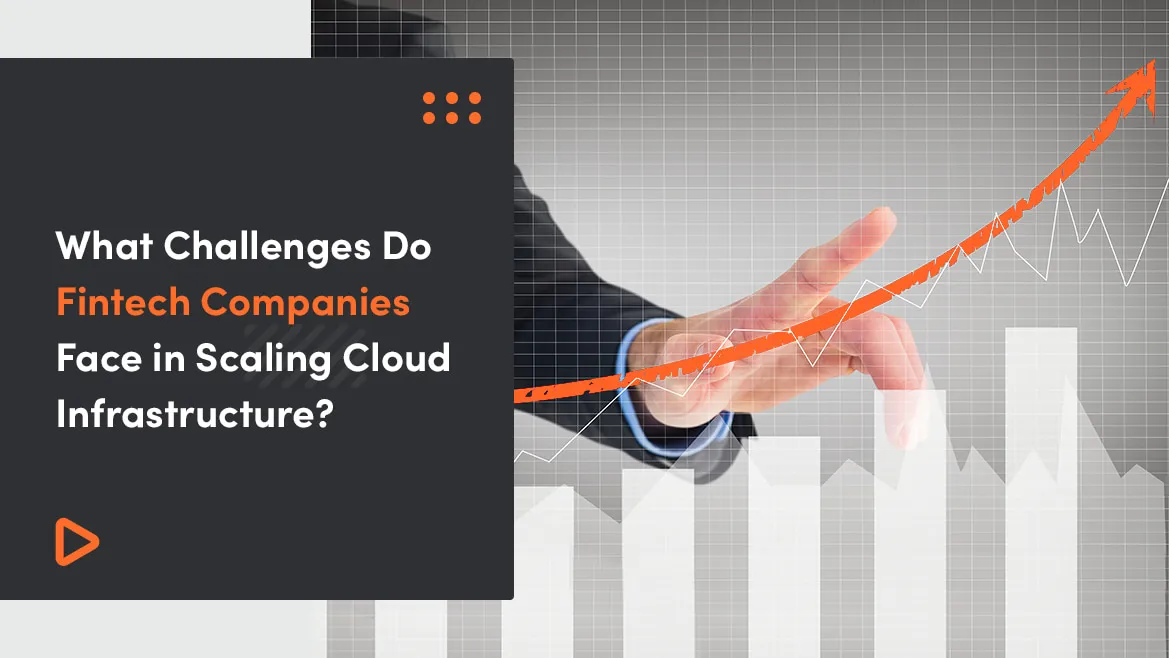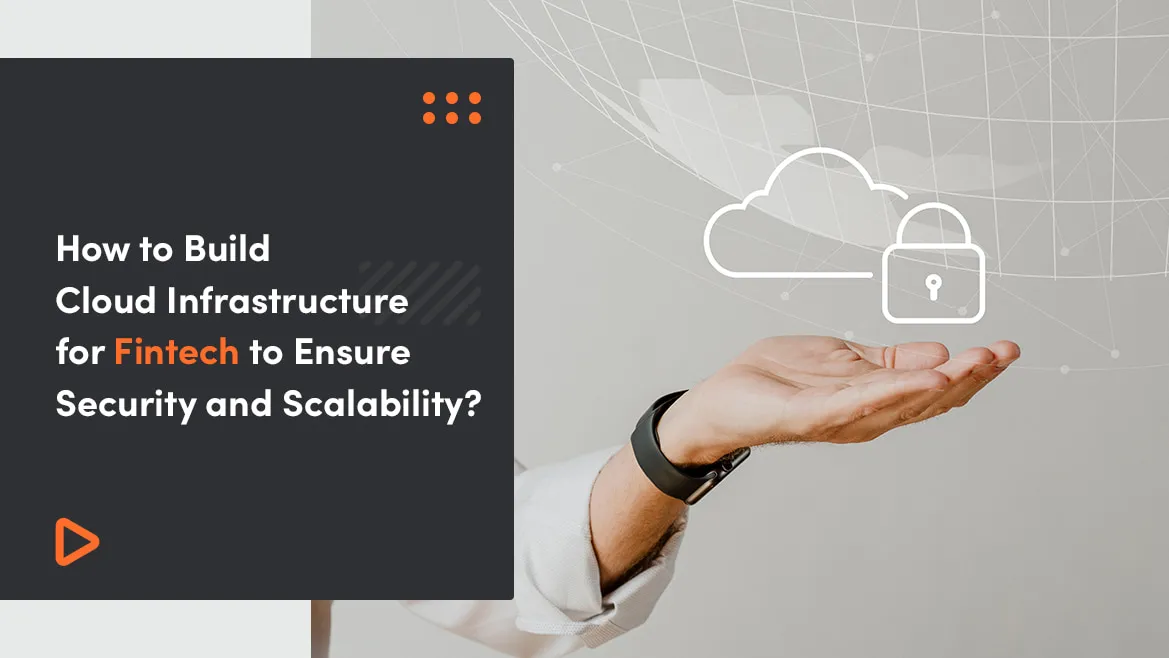Profitability is a challenge for the majority of financial firms. Only 6% of financial services achieve financial breakeven, claims the 2020 Google Cloud fintech Focus Report. However, there are ways to increase your chances of developing a lucrative platform. There is no secret to building a fintech product; all you need to do is use the appropriate technologies and find a knowledgeable team that will centre it on the end-user’s needs.
This blog will discuss how to create a powerful Fintech SaaS solution that works for your clients.
Top features of Fintech products
When building a Fintech you should focus on: compliance, data security, legal requirements, processing large amounts of confidential data and custom extraordinary UX/UI design. If you want your financial app to live up to user expectations, these features are worth including:
- Intuitive interface. Most users demand the app to have a visually appealing, intuitive layout and a quick sign-in process. Furthermore, a strong user interface can help your fintech application distinguish itself from the competition.
- Payment gateway. Simple financial tasks like money transfers, electronic payments, and balance monitoring shouldn't be made more difficult by your app. However, you cannot sacrifice security for simplicity.
- Security. According to the 2019 Report by Aite Group, 97% of financial services do not have enough code security, and 90% of applications leave sensitive data in other apps. In other terms, in addition to becoming simple, the authentication procedure should be efficient.
- Personalized experience. When an app is created with their requirements in mind, users adore it. Users must be allowed to filter their information to the very minimum (such as push notifications).
- Online chat. Online chats, a more practical substitute for phone and email assistance for most customers, can help fintech businesses increase their customer satisfaction percentage. Furthermore, you can improve the customer experience by cutting expenses using AI-powered chatbots. According to the 2017 Juniper Research Report, by 2022, chatbots will help businesses save more than $8 billion yearly.
- Biometric sign-in: It takes more than just making an app more entertaining or engaging to keep users on board. Perception of security is essential in fintech. After all, users won't continue to use your software if their money is at risk. Biometric authentication is one of the finest methods for app security. The greatest factor is that it is safer than conventional authentication techniques like passwords.
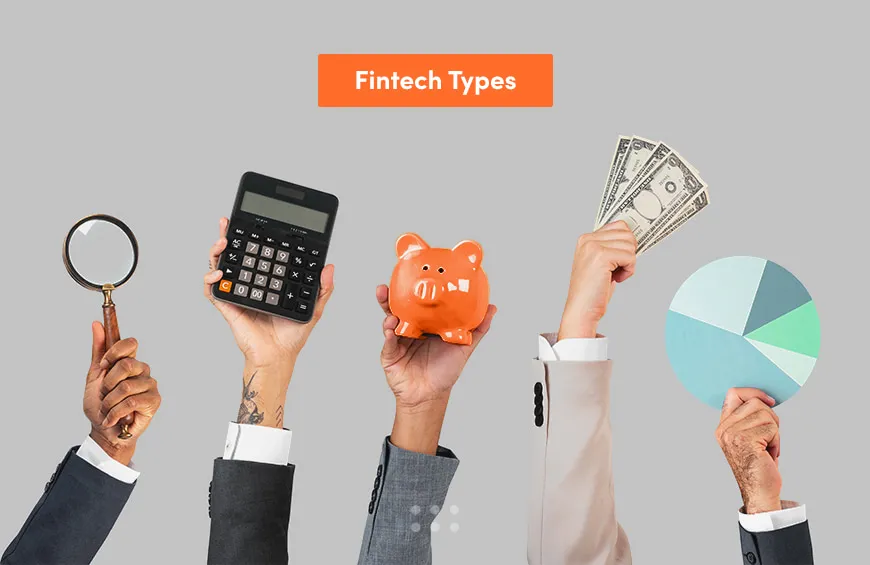
Fintech Types
These are the most popular types of fintech solutions:
Payment
The most well-known fintech subcategory is, without a doubt, online payments. Digital money transmission and currency conversion are now commonplace for businesses and customers worldwide due to the growth of payment channels.
Payment services:
Lending and mortgage
Traditional financial loan services are laborious and too complex for a modern user. Innovative loan and mortgage software now automates most labor-intensive activities and checks with credit bureaus, greatly speeding up the procedure.
Digital lending platform and mortgage services:
Online banking - spend management platform
Digital-only banks are great if you want quick transactions and simple money management on your smartphone. You don't even need to leave your house to open an account or make a deposit as you would at a regular bank.
Online banking services:
Cryptocurrency
Many financial institutions are focusing even more on cryptocurrencies as blockchain adoption increases.
Cryptocurrency services:
RegTech
RegTech is a term for regulatory software that enables fintech businesses to examine local laws. These systems minimize human mistakes by automating the monitoring procedures. For multi-regional apps, they are useful.
RegTech services:
Investment
Users can invest in capital instruments with the help of investment services and stock trading applications. Additionally, data analytics and investment advice are some of the major benefits of these applications.
Investment services:
Insurance
With mobile applications, data science, and other quick fixes, digital insurance services are made to draw clients. Purchasing insurance online is the best option for most people who want to speed up the rather agonizingly lengthy commission procedure.
Insurance services:

Personal Finance
Planning and managing a budget may be done with the help of personal financial services. Because it assists in cost analysis and investment forecasting, this application is popular with consumers. Check out a few personal financial applications to find out what functions users anticipate from a modern fintech platform.
Personal finance services:
Crowdfunding
Crowdfunding is an increasingly popular method of raising money. Platforms for crowdfunding are a popular alternative for entrepreneurs seeking money due to their minimal financial risks. These platforms often offer an easy-to-use user interface (UI) investment to keep donors interested.
Crowdfunding services:
Despite covering a wide range of areas, these applications include features consumers are accustomed to seeing.
What is SaaS?
Distributing programs via the Internet is a software service (or SaaS). You can avoid complicated software and hardware maintenance by accessing the software via the Internet rather than installing and maintaining it.
Advantages of SaaS products
Some benefits of the SaaS model include:
Enhanced Security
SaaS-based data is more secure than traditional systems since it is stored in the cloud and is regularly backed up by the provider. The majority of data is protected on the servers and database of the SaaS provider, even if a security incident affects the firm server or a worker's workstation.
Easy-to-Use
The Internet and various mobile devices can be used to access SaaS programs. The last several years have seen a significant improvement in user interface quality and consistency, and the adoption learning curve is now rather flat.
As a result, new workers at a telecom company can rapidly and simply pick up using SaaS apps. SaaS apps that are good at what they do include tutorials and user manuals to help those just starting to use the product.
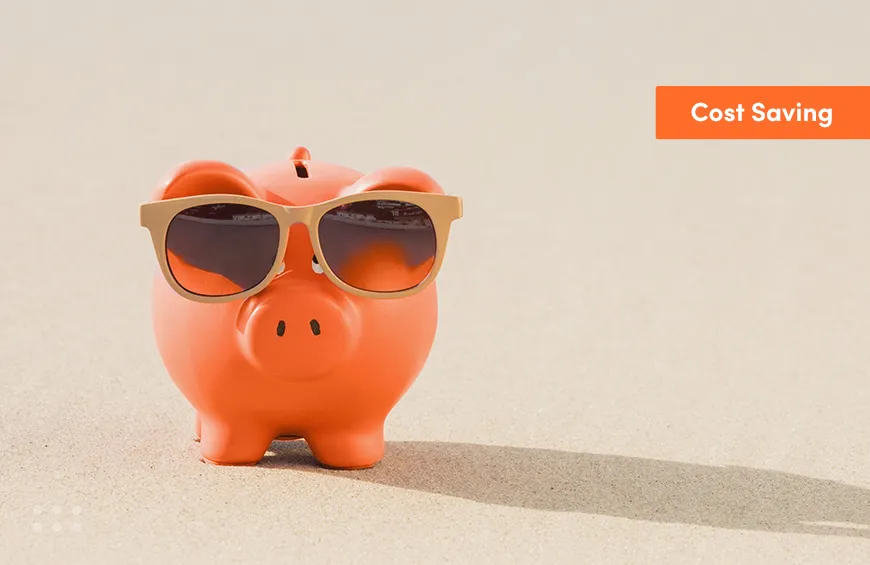
Cost Saving
Infrastructural and hardware capital expenses and the cost of employing personnel to operate the application are also reduced. SaaS significantly reduces maintenance expenses and the lower initial costs associated with setting up and operating the system (which must be integrated with other software systems).
Businesses can avoid paying hefty license costs by employing pay-as-you-go pricing methods, which allow them to only pay for what they use.
Scalability
SaaS solutions are rapidly integrated with other comparable systems and are readily applied because they are cloud-based. Telecom users merely need to activate a new SaaS product; they do not need to purchase any extra software or servers. Additionally, the SaaS provider essentially makes the user's server capacity available.
You can save time and money by working with SaaS providers to get upgrades and updates as soon as they are available.
Subscription-Based Solution
For example, the complexity of license charges and upgrade expenses is not factored into the pricing of SaaS applications. Most Software as a Service (SaaS) products are premium accounts, allowing users to buy them as needed and stop using them when the business decides they are no longer necessary.
SaaS applications are frequently billed on a per-seat model, with the price paid depending on how many seats are bought. It can have various price structures and billing intervals, such as fixed monthly, quarterly, half-yearly, and annual billing cycles. The option to charge depending on consumption is a feature that many contemporary SaaS services provide. The ability to charge users is another crucial requirement for SaaS apps.
Automatic Updates
Customers can rely on a SaaS provider to automatically handle upgrades and patch management, saving them money on new software purchases. This significantly lessens the workload for internal IT employees.
Customization
When comparing apps from the same software supplier, SaaS solutions are frequently adaptable and open to integration with other business applications.
Try our developers.
Free for 2 weeks.
No risk. Just results. Get a feel for our process, speed, and quality — work with our developers for a trial sprint and see why global companies choose Selleo.
What is Fintech?
The term "financial technology" is referred to as "fintech." It serves as a blanket word for any technology utilized to improve, modernize, digitize, or disrupt conventional financial services.
Top features of Fintech products
Looking to expand your user base? If you want your financial app to live up to user expectations, these features are worth including:
- Intuitive interface. Most users demand the app to have a visually appealing, intuitive layout and a quick sign-in process. Furthermore, a strong user interface can help your fintech application distinguish itself from the competition.
- Payment gateway. Simple financial tasks like money transfers, electronic payments, and balance monitoring shouldn't be made more difficult by your app. However, you cannot sacrifice security for simplicity.
- Security. According to the 2019 Report by Aite Group, 97% of financial services do not have enough code security, and 90% of applications leave sensitive data in other apps. In other terms, in addition to becoming simple, the authentication procedure should be efficient.
- Personalized experience. When an app is created with their requirements in mind, users adore it. Users must be allowed to filter their information to the very minimum (such as push notifications).
- Online chat. Online chats, a more practical substitute for phone and email assistance for most customers, can help fintech businesses increase their customer satisfaction percentage. Furthermore, you can improve the customer experience by cutting expenses using AI-powered chatbots. According to the 2017 Juniper Research Report, by 2022, chatbots will help businesses save more than $8 billion yearly.
- Biometric sign-in: It takes more than just making an app more entertaining or engaging to keep users on board. Perception of security is essential in fintech. After all, users won't continue to use your software if their money is at risk. Biometric authentication is one of the finest methods for app security. The greatest factor is that it is safer than conventional authentication techniques like passwords.

Top Fintech SaaS Companies
We have compiled a list of the top fintech SaaS firms and startups that have revolutionized the sector.
Mitratech’s Alyne
A powerful SaaS solution for governance, risk, compliance, ESG and cyber. Alyne helps teams to better understand laws as well as identify risks in real-time, increase transparency and compliance efficiency, which results in a more effective collaboration across their enterprise and third parties. To find out more about this solution and how we built it, go to our portfolio page.
Shift Technology
Shift technology is one of the top AI native SaaS solutions in the fintech company, focusing on assisting businesses in combating fraud and automating claims in the event of unanticipated occurrences. Their artificial intelligence-powered solutions assist them in producing dependable and accurate insurance judgments for their users.
AvidXChange
AvidXchange is a big name that automates invoicing and payment operations, mostly for mid-market enterprises. It was founded in 2000 and now handles over $140 billion in transactions yearly via its network to over 680,000 suppliers. It is among the leading firms used by around 6,000 clients to pay their bills.
Built Technologies
Built Technologies is a reputable provider of financial technology for the construction industry, and links many types of organizations, including those who run commercial or customer construction projects, hold real estate, operate title agencies, etc. By expediting the withdrawal process, monitoring compliance, reducing risks, and improving construction payments and customer loyalty, they strengthen the ecosystem's ability to move money.
Khatabook
Khatabook is currently among the SaaS companies with the fastest global growth. It allows micro, small businesses and medium-sized companies to track their commercial transactions safely. For clients to have additional cashless payment alternatives, their mobile application provides every online payment option that can be utilized in any shop and outlet. According to their current figures, Khatabook facilitates daily transactions totaling over US$200M, and numerous businesses sign up there daily.
Tink
With over 3,400 connections between banks and other organizations and over 250 million users, Tink is one of Europe's top open banking providers. They aid the creation of data-driven financial services by startups, banks, and fintech.
Although it also enables you to make payments, Tink's platform may be used to obtain aggregated financial data and create solutions for managing your finances. All of Europe's financial data may be accessed through their lone API.
Pleo
Over 20,000 businesses have previously used Pleo, a Copenhagen-based company, to streamline their bookkeeping. They provide advanced virtual or physical business credit cards that enable employees to purchase whatever they require for work while keeping costs under control.
Making purchases is simple and controllable due to the Pleo smartphone app and automatic expenditure report capabilities. The digital versions of all of Pleo's cards are compatible with ApplePay and Google Pay, and they are all prepaid business Mastercards with spending limitations.
MANTL
MANTL is an enterprise SaaS business that primarily assists established financial companies in growing by helping them update their financial services and payment options. They often assist consumers in opening deposit accounts in a matter of minutes from any device. Companies worldwide raise billions of dollars annually in core deposits due to their technology.
Stripe
Stripe is another well-known SaaS startup with a strong economy framework that allows businesses of all sizes to utilize their software to take online payments anywhere in the world. They provide secured worldwide transactions since they comply with global regulatory uncertainty and work closely with various industry titans such as Apple, Google, and Twitter.
MX Technologies
MX is a Utah-based SaaS startup that develops data-driven products for over 2,000 banks, credit unions, fintech pioneers, and other businesses. They provide several SaaS options to easily handle their finances and have more than 200 million users. They assemble data from several comprehensive databases to provide users with the greatest financial solutions.
Bitsight
Bitsight is a prominent cloud-based cyber risk mitigation company that provides organizations with fraud protection and security solutions. Cyber risk management, insurance underwriting, data management, and so on are among their services. Their products improve the security of organizations' funds and aid them in making educated financial decisions that benefit the firm and its clients.
Zeta
Zeta is a cloud-based payment and banking technology primarily used by banks and businesses. Their SaaS solutions provide amazing benefits that can aid in corporate productivity. They are useful for managing employee payments, collecting payments from clients, and much more. They also provide services for card issuance systems, digital wallets, payment security mechanisms, and everything else you might need.
How to build a Fintech SaaS solution
We recommend that you use our tried-and-true methods to include your unique services and fundamental features in your product.
Step 1: Conduct research
Here's the deal: the more complicated the software project, the more effort you should devote to researching. In a complicated business like fintech, the research process should be your primary focus.
Before you start a fintech product development, you need to study:
- Target region. All financial services are controlled by governmental bodies, several of which are analyzing how to deal with cryptocurrencies. The laws and legislative measures now in effect should thus be studied.
- End-consumer. Identify your target audience and the demands they have. Do they utilize desktop or mobile devices? Why would they require your app? What distinguishes your solution from that of the opponents? Make sure that your KYC processes are properly documented and in line with the regulatory requirements.
- Scope of work. You don't want to postpone your launch, yet you also don't want to run out of funds midway through production. You must begin your project with a reasonable budget and time estimations.
Calculating expenses and time-planning won't be precise without a team.
Step 2: Select a tech stack
Sometimes the right technology can be the make-it-or-break-it for your product. If you're unsure about the tech stack, employ a tech consultant or hire a specialized team with knowledge of the best cross-platform financial app development tools to handle the development. As a development company with years of commercial experience, we always recommend our clients to go with battle-tested technologies like React Native, React.js or Ruby on Rails.

Step 3: Gather a team
Look for experts who can create a profitable financial product. The ideal skills for your developers would include financial app experience, a suitable tech stack, and communication tools.
How do you locate a group that possesses the requisite abilities and knowledge? You can use a variety of strategies.
The first option is to put together an internal team. However, you'll be responsible for conducting the headhunting, interviews, and vetting.
You can also hire a remote workforce as an alternative. With this choice, you can save money on operational expenses and gain access to a huge talent pool. If you haven't managed remote teams previously, though, communication can become a roadblock.
- Finding the best software vendor to develop your trading platform
Once you have a clear idea of what your product should be, you must select a maker. This is a very difficult undertaking, given the fierce competition in the market for software services.
The ideal balance between price and quality must be found. Because of this, you have to consider businesses from regions with a reputation for having skilled programmers whose costs are less than those in the United States or Western Europe. Popular and, in our perspective, the best option is countries like Slovakia, Poland, or Hungary.
Additionally, you want to work with a provider who is an expert in your field. FinTech is what we mean by this. At Selleo, we have a team of dedicated and highly professional developers who excelled in FinTech software development. You can check our company's portfolio for FinTech apps here.
Step 4: Define the minimum viable product
Before you begin major development, you must ascertain whether your target users are interested in your fintech application.
A prototype of your product with the basic minimum of features is known as an MVP (Minimum Viable Product). You can test your software early in the development cycle with the assistance of MVP development services. Because of this, you'll have more analytical data to eliminate the features that aren't needed and concentrate on what your customers desire.
Step 5: Think of APIs and integrations.
Fintech applications are expected to provide functionality, including straightforward transactions, budgeting, bill monitoring, chat help, and connectors. Even if you decide to create your functionalities from scratch, you still need to make sure that your app is compatible with third-party APIs (Application Programming Interfaces).
As a result, your clients expect your app to integrate with their preferred SaaS solutions. Financial services are, after all, based on the user experience. Making the connection secure and smooth is both equally vital.

Step 6: Focus on security
Customers' private, financial, and other data will be collected through your app. Data breaches might consequently harm your company's financial performance and credibility. Therefore, your team must know data protection laws, guidelines, and best practices for safe fintech product development. The following are a few of the most practical solutions:
- Data encryption (RSA, 3DES, Twofish algorithms)
- Dynamic password change
- Multi-factor and adaptive authentication
- RBAC (role-based access control to reduce internal threats)
To integrate cybersecurity into the software development process from the beginning, you can use the DevSecOps technique. The catch is that this strategy calls for knowledge and the right equipment. In light of this, looking for a competent vendor who uses cutting-edge fintech app security solutions may be preferable.
Step 7: Design the interface
The core components of a fintech app are user experience and design. Make sure each feature and component of the user interface has some benefit.
The service provider and end consumers should be your primary targets if you want to optimize income. For instance, a loaner and a loanee will be involved in a money lending app that you create. Developing interfaces for various user segments will increase your consumer base (like Upwork did). Even if you're concentrating on B2C services, it's crucial to create the application with the option of a B2B interface in the future.
Step 8: Launch the beta version
Although continuous testing is required for software development, it is insufficient for a successful launch. There is a tried-and-true approach to enhancing your product before release.
Start a small Beta test with possible test subjects or backers; it's simple. You can improve your app's hard spots by using real consumer feedback. You should, of course, take precautions to protect your confidential information. As a result, have your legal department create legal paperwork and an NDA (Non-Disclosure Agreement) for testers.
Step 9: Support the application
The launch of the product is only the start. As you are aware, the financial industry is always evolving; therefore, you should be ready to maintain and update your app during its useful life.
You can see how difficult it is to navigate the fintech development process. With the appropriate person in charge, you can simplify the procedure.
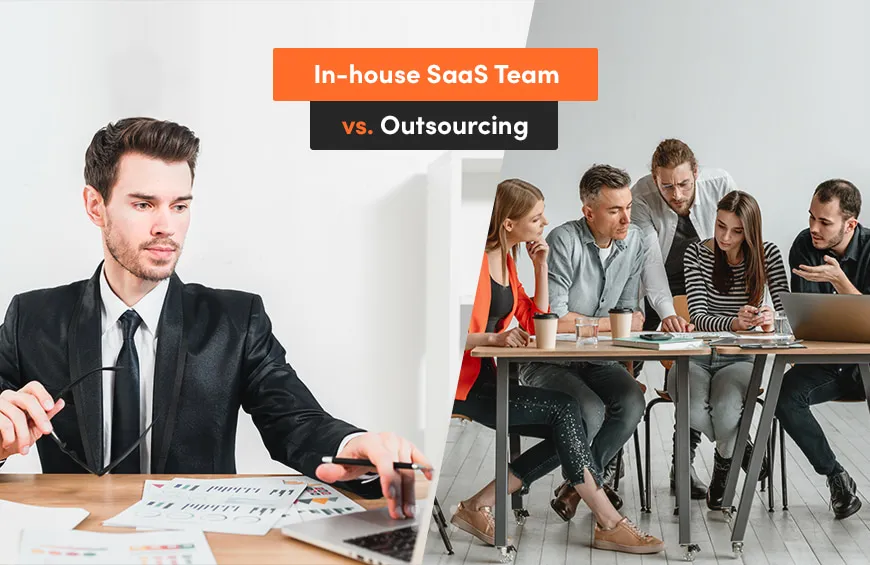
In-house SaaS team vs. outsourcing
To better understand the difference, you must understand the definition and functionality of Insourcing and Out-sourcing.
In-House SaaS Team
Insourcing Instead of employing an outside individual or business, in-house or insourcing allocates a project to a person or department within the company. It uses the organization's established resources to carry out operations or accomplish objectives. For instance, if a corporation currently provides technical assistance for another product inside the company, it may decide to do so again for a new product.
A further benefit of insourcing is that it typically brings new operations and procedures on-site within the company. Because it frequently necessitates the development of new procedures to launch a distinct division inside the corporation, insourcing can thus be more expensive for a business.
Outsourcing of SaaS Team
In the outsourcing process, duties are carried out by a third party's skilled labor and by that third party's resources for providing services and producing goods. The primary driver of outsourcing work to another organization is often cost-saving measures. Industries, including healthcare, travel, transportation, energy/utility corporations, retail, and government, frequently use outsourcing to finish crucial projects or activities.
Fintech regulations in Different Regions of the World
To develop a FinTech app, you first should educate yourself with the regulations that apply in your region.
Fintech regulations in the US
US fintech industry follow all applicable federal and state rules. You should read the following publications to learn more about regulatory requirements:
- Electronic Fund Transfer Act (EFTA). EFTA protects fund transferring using credit cards, ATMs, and other electronic transactions.
- Fair Credit Reporting Act (FCRA). FCRA regulates how financial organizations collect and use consumer report data.
- Anti-Money Laundering Act (AML). The Patriot and Bank Secrecy Acts are part of AML. These documents govern cross-border transactions and other anti-money laundering procedures.
- Gramm-Leach Bliley Act (GLBA). GLBA obligates financial services to disclose how they will store and share their user's data.
- Jumpstart Our Business Startups Act (JOBS). JOBS is a list of specifications for crowdfunding systems. This law specifies transparency, registration, and fundraising cap restrictions.
Fintech regulations in the EU
Numerous legislation from the European Union covers many kinds of financial services. The regulations that are most frequently followed are:
- Payment Services Directive (PSD). PSD1 and PSD2 set requirements for consumers and suppliers of electronic payment services. This covers transactions, refunds, cancellation of payments, and responsibility for unlicensed payment instruments.
- General Data Protection Regulation (GDPR). GDPR regulates how fintech companies process client data and how it is transferred outside the European Economic Area.
- Fintech Action Plan (FAP). FAP establishes standard operating procedures for retail payments, digital finance, and crowdfunding platforms.
- Markets in Financial Instruments Regulation (MiFIR). With an emphasis on openness throughout trading procedures, MiFIR provides requirements for investment firms and trading platforms.
Fintech regulations in the UK
There is no comprehensive regulatory structure for fintech businesses in the United Kingdom. Therefore, to determine if their business belongs under the legal framework, financial SaaS businesses must assess their operations' kind, scope, and size.
These acts you should examine are:
- FCA Handbook of Rules and Guidance (FCA). The FCA Handbook includes regulations for banks, investment companies, insurance companies, and other financial services.
- Prudential Regulation Authority (PRA) Rulebook. The PRA Rulebook establishes criteria for financial institutions and evaluates the risk these companies provide to the market's capacity to maintain its financial stability.
Policies in these areas are continually changing to stay up with the developing fintech business. Let's now examine the current state of the fintech environment.
Summary
Along with the need for user-friendly online services, fintech usage is continually increasing. What is necessary for the success of your project? Knowing how to construct a fintech product around your concept requires first understanding regulations, needs, and user expectations:
- simplicity and availability of such products (accessibility)
- the simplicity of integration (like Stripe)
- meticulous planning, strong fintech market research, and expansive content marketing (like Mint)
- apps for millennials (like Robinhood)
- puts its users first, not just to sell expensive insurance (like Oscar Health)
- transparent, widely available, and cheap enough (like Coinbase)
Selleo is equipped with the know-how and resources needed to create a customized app that will satisfy your requirements. Get in touch with us to learn more about app development and regional regulations.



